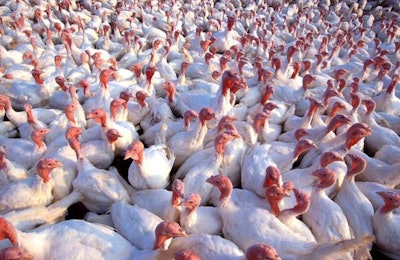
In a presentation to turkey growers and producers at the Midwest Poultry Federation (MPF) Convention on March 17, Dr. Michelle Kromm, director of technical services and live production at Jennie-O Turkey Store, presented findings from a study conducted about the avian influenza outbreak in 2015. She also recommended steps that should be taken as part of an overall biosecurity program.
The small case-control study, which was conducted by Dr. Kromm and her colleagues, was designed to identify risk factors, define intervention strategies and provide data-based recommendations regarding how to prevent additional widespread outbreaks of highly pathogenic avian influenza throughout the industry. Although the study focused on Minnesota counties, the findings are relevant to all geographies and all species.
Kromm and her colleagues identified a number of risk factors that put farms at a higher risk for avian influenza infections. Notably, the factors appeared to be different early in the outbreak, before April 22, 2015. According to the study, risk factors include:
1. Being in a densely populated area
Farms that had three or more farms within a 3-mile radius were 12 times more likely to be infected.
2. Being located close to an infected farm
Farms that were less than 14 miles from an infected farm were four times more likely to be infected.
3. Inadequate worker biosecurity efforts
When workers completed at least three biosecurity steps before they entered the bird space, those farms appeared to fare better than farms with fewer worker biosecurity steps. Notably, visitors who completed those same steps actually did not result in protection, implying that different biosecurity steps are needed for visitors than workers.
4. More on-farm traffic
Higher amounts of traffic coming into and throughout the farm appeared to increase risk. “This is one of those goofy things that popped up later in the outbreak,” said Kromm. She recommends reducing speed and being very critical about what vehicles actually have to come onto the farm. “If people can park away and walk into the farm, that’s better,” she said.
5. Increased tilling
According to Kromm, working the cropland around the facilities increased the risk of last year’s outbreak. “Be aware of when field work is occurring,” she cautions. “Limit debris and dust entering barns through open curtains.”
6. Dry, windy weather conditions
The study found that windy days were inevitably followed by clusters of outbreaks several days later.
7. Lack of communication with community
This is one of the most important ways to proactively prevent outbreaks. “Good communication makes people happy,” said Kromm. “Be a good neighbor. Make sure you’re doing what you want the guy next door to do.”
Kromm believes that this study and increased awareness of biosecurity measures can have a significant impact on preventing or controlling future outbreaks, and that it is up to each member of the community to take action.
“If you’re suspicious, make sure you call someone,” she said.

















